
Find answers to your questions here
Get information about our shipping conditions, EAN CODE / GS1 systems, glossary and FAQs, plus much more here. Don’t hesitate to contact us if you can’t find the answer to your question here.
Answers
A densitometer can be used to measure the visual ink density (D-Max) of printing material. The higher the ink density in a photo or fine art print, the more brilliant the colours and deeper the black.
The ink limit is a value that indicates when the medium can no longer absorb any ink with sharp margins. The higher the ink limit, the more precise the colour accuracy of the print and the more brilliant the colours. High-quality paper has an ink limit of > 200%
In general, all printing inks, prints and even the paper lose colour or their intensity or turn yellow depending on the duration and intensity of exposure to light. Paper should be lightfast for at least 100 years and have only minor, or ideally no, negative impacts on prints with toner (particularly pigmented ink). The lightfastness is also impacted by the proportion of optical brighteners in the paper.
Paper to be archived involves non-acidic, extremely age-resistant paper. It should also be lignin-free, i.e. consisting of linters or alpha cellulose. Lignin-free paper does not turn yellow.
Only a large, reproducible colour gamut can guarantee the reproduction of artwork or a photograph that is true to the original. The colour gamut can be visually reproduced in a coordinate system. Here, the solid colours of cyan, magenta, yellow, red, green and blue are spectrophotometrically measured and assigned to an area in the coordinate system. The larger this area in the visual space, the greater the colour gamut and more brilliant and precise the print result.
The thickness or volume of paper influences the feel and thus the quality of the artwork or photograph. Paper with a higher grammage ( > 300 g/m²) is recommended even for larger art reproductions whose originals were already created on strong paper. (Exception: reproductions on Japanese paper such as Awagami or other specialities). Fine art paper should also feel like high-quality artist paper.
The L*a*b* colour system is the most commonly used system for colour measurement and can also be used as a reference colour space. In the CIE Lab colour system, normal spectral values are translated into a coordinate system which better resembles subjective colour perception. This colour system portrays the white paper tone and proportion of optical brighteners in a print substrate.
The entire Rauch company is certified by the FSC® (Forest Stewardship Council®). More specifically, this means that all pulp used by our suppliers for our FSC paper is sourced from sustainably managed and socially beneficial forests. This also applies to our entire downstream supply chain.
An ICC profile (International Colour Consortium) is a colour profile that contains information which allows your printer to print your photos with precise colours, maximum colour gamut and the best possible results on a specific type of paper. It includes important information about the printer ink type, e.g. matte or photo black and the maximum ink that can be applied to achieve the best possible print results. Ideally, the calibration of your monitor and, where possible, the use of suitable image processing and colour management systems will also be used here.

